The next-gen MacBook Pro with Retina Display Review
by Anand Lal Shimpi on June 23, 2012 4:14 AM EST- Posted in
- Mac
- Apple
- MacBook Pro
- Laptops
- Notebooks
General Performance
The Retina MacBook Pro can complete a full boot from power off to usable desktop in just over 17 seconds. It’s a hair faster than last year’s MacBook Airs, a bit quicker than the old SSD equipped MacBook Pro, and night and day compared to any Mac with a hard drive. Four years ago I said that Solid State Drives were the single biggest upgrade you could do for your computer, and it couldn’t be any more true today.
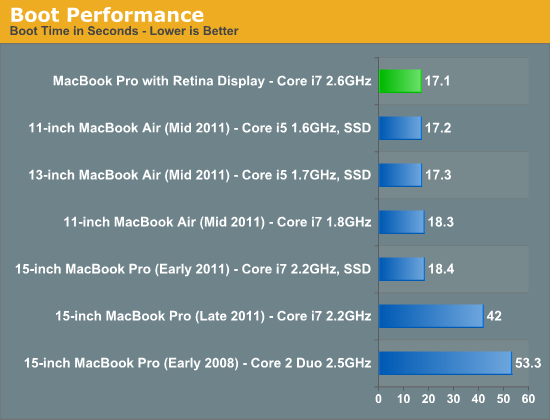
The Retina MBP behaves more like the 3rd gen MacBook Air in how it goes to sleep and wakes up. Both happen virtually instantaneously, and if your battery dies while asleep you don’t get the greyed out screen with progress bar as your environment is restored from disk - it just appears, taking a couple of seconds for the clock to update and everything else to come to life. It’s a small but subtle change that tells you the rMBP is in a distinctly different class. Apple’s tight control over firmware and storage interface help it deliver up to 30 days of standby power, a number I’ll really need to verify one of these days.
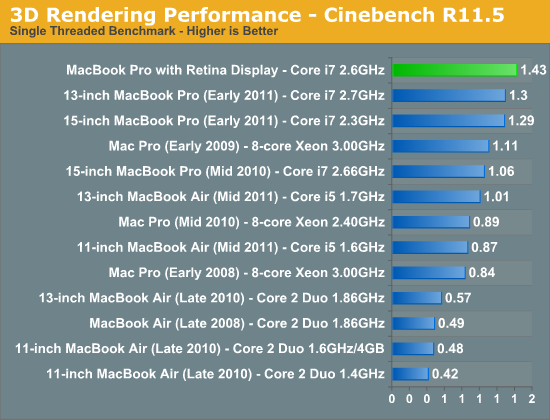
Raw CPU performance is up handsomely over the 2011 MacBook Pros, at least in their standard configurations. The 2.6GHz chip in the $2799 rMBP can turbo up to 3.6GHz when only a single core is active, delivering a 13% increase in performance over the previous generation 2.2GHz part. Compared to the upgraded 2.4GHz Sandy Bridge Core i7 from last year (not pictured) however, I would expect a sub-10% advantage.
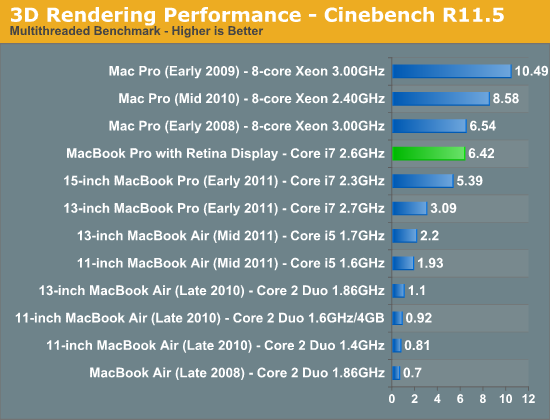
With all four cores active the 2.6GHz chip can run at up to 3.4GHz, which it regularly hits as long as the Kepler GPU stays asleep. The 2.2GHz Sandy Bridge based 2011s we’re comparing to on the other hand can only turbo up to 2.8GHz. Here the advantage is a more tangible 19%, although once again if you are comparing to one of the 2.4GHz parts from last year I would expect notably smaller gains (mid to high single digit percentages). The improved thermal characteristics may allow mobile Ivy Bridge to operate in turbo modes for longer than Sandy Bridge, however I don’t have any data to actually support that claim. That doesn’t mean it can’t happen, it’s just complex to test and model.
While the Cinebench tests are largely CPU bound, many of the following tests are largely influenced by the SSD in the Retina MacBook Pro. Here we see some huge gains, especially compared to older HDD based Macs.
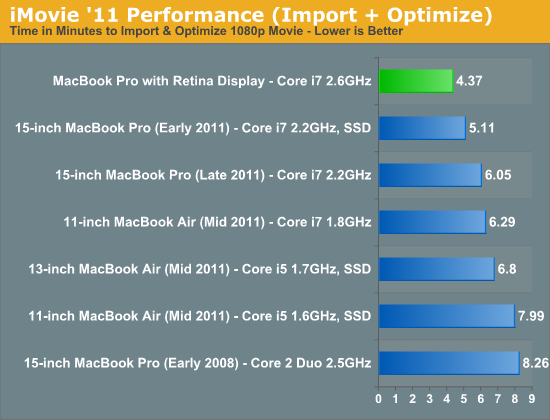
iMovie import time is heavily influenced by disk as well as CPU performance. As a result there are big improvements over both the HDD and SSD equipped 2011 MBPs.
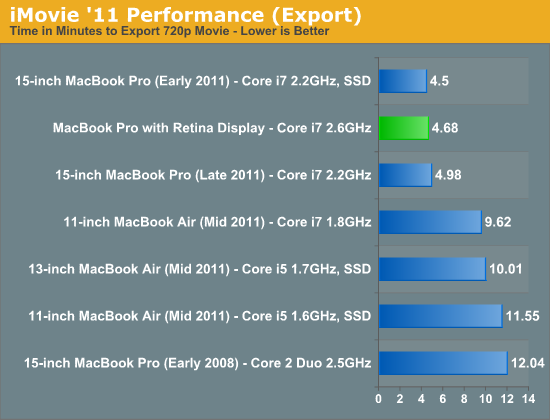
Export time is more heavily CPU bound and here the advantage over the previous generation notebooks is pretty much nonexistent.
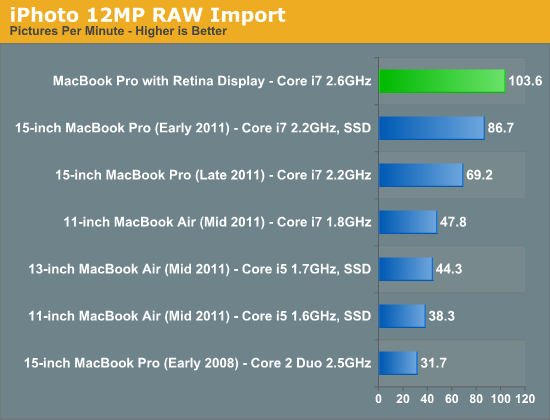
Our iPhoto import test stresses both disk and CPU, giving the rMBP a tangible advantage compared to the SSD equipped 2011 MBP. None of the dual-core or HDD based Macs stand a chance here.
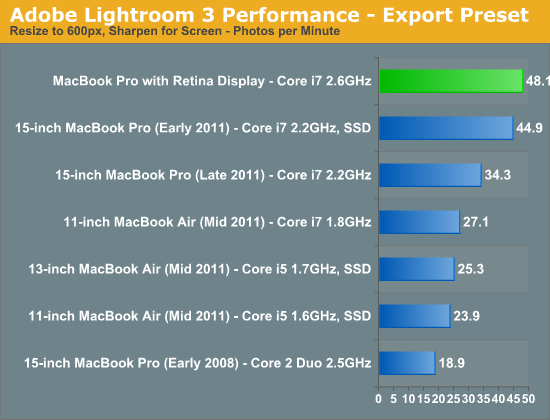
Our Lightroom test continues the storage/CPU dependencies as only the SSD equipped 2011 MBP is able to come close to the rMBP’s performance. There’s not much of a performance advantage here when you compare similarly equipped systems though. Ivy Bridge may have been a good upgrade from a power standpoint, but it doesn’t tell a significantly different performance story in all cases.
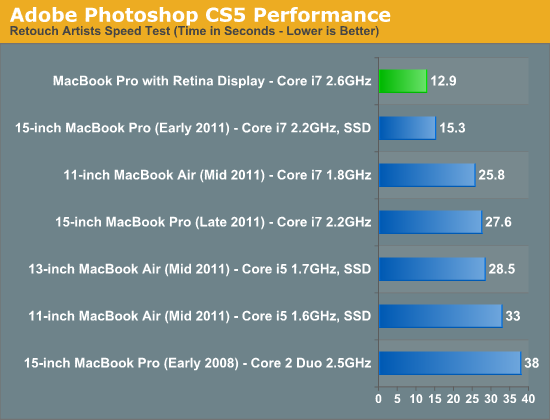
The rMBP cranks through our Photoshop workload fairly quickly. The performance advantages here are likely due to increased memory, a much faster SSD and obvious CPU speed improvements as well.
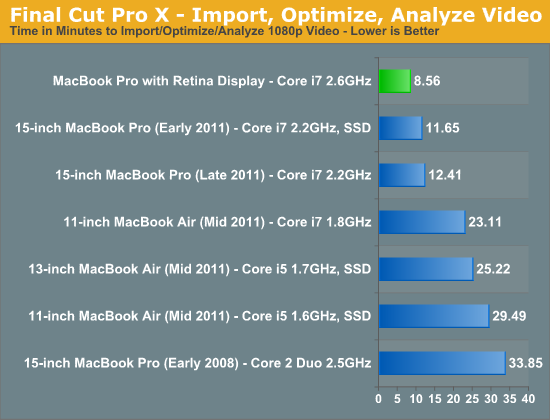
The same holds true for the advantages in our Final Cut Pro X test. As a default configuration the $2799 MacBook Pro with Retina Display is easily the fastest notebook Apple has ever shipped. It’s only if you had an upgraded 2011 model (perhaps with an aftermarket SSD?) that you’ll be unimpressed by the move.
I can’t stress enough how much the new SSD improves the overall experience. It’s just so much faster than what Apple used to ship.










471 Comments
View All Comments
Fx1 - Monday, June 25, 2012 - link
It makes a big difference to the glare when you take away that glass. Why don't you go have a look at a rmbp and see how thin the lid is and you too will be impressed. A LOT of work must going into designing these notebooks. Why don't you spend you time bitching at the windows notebook makers and see how CRAP their designs are. Because they deserve it. Full Stop.Spunjji - Tuesday, June 26, 2012 - link
Why don't you go and eat a dick, child.gstrickler - Wednesday, June 27, 2012 - link
It's not a matte screen. Matte screens are etched to diffuse the light in many directions. This makes them slightly less "sharp", and lowers their effective brightness slightly. The Retina display in the new MBP has a low reflectance flat surface, not a matte surface. It's an important difference as an etched surface would compromise the sharpness of such a high DPI display.Spunjji - Monday, June 25, 2012 - link
I give up. Too many fanboys on both sides.jjbwbc - Monday, June 25, 2012 - link
I bought one of these guys and I really love the display but I cannot for my life see if this is glass or plastic or what makes the outer layer of this display.How fragile is it? I mean, it seems like a combination of durable and extremely fragile too. Makes me nervous... can anyone weigh in on how fragile the screen on this guy is compared to regular LCDs?
Constructor - Thursday, June 28, 2012 - link
It's definitely glass, and likely of the 'Gorilla' variety. It will still scratch or break if you try hard enough. But with no access to Apple's internal QA information we'll have to wait until someone actually manages to break theirs to really know...! ;-)SimaYi - Monday, June 25, 2012 - link
I'm disappointed in this review, as I was very much hoping to get some advice about whether this laptop can run recent games at 2880x1800.The only frame rates mentioned for this resolution were Half Life 2 (42 fps) and Diablo 3 (18 fps).
@Anand, is there any chance you will update this article with some detailed feedback about gaming at 2880x1800, and framerates for running recent Windows games in bootcamp at this res?
seapeople - Monday, June 25, 2012 - link
No, it can't run recent games at 2880x1800. This is not something that needs to be benchmarked; it is obvious from the combination of a middle-of-the-road laptop graphics card and the highest resolution notebook screen ever made.wfolta - Monday, June 25, 2012 - link
And you got this idea, despite the article mentioning Diablo III (about as recent of a game as you can get)? It runs Diablo III (Normal Act III) at 20+ FPS, with most settings cranked to max. It runs other recent games fine. Perhaps you should give details of what games you mean when you say "recent"?And the fact is you can run games at lower resolutions (which still look better at that resolution than if you only had that many pixels) and drop a few settings and double your frame rate.
SimaYi - Tuesday, June 26, 2012 - link
Thanks very much for the feedback!Are you saying from personal experience that it runs D3 on High at 20fps? How about if you reduce the settings, say with no AA and lower setttings, can it run D3 above 30fps?
For most games, 25-30 fps is quite playable. Above 30fps is great.
As for "recent" games, I would be extremely interested to know the performance at 2880x1800 (on low or med settings), for games like Skyrim, DXHR, RAGE, Arkham City, BF3, Sniper Elite V2, ME3, Risen 2, MW3, Witcher 2, Civ 5.
Never purchased a mac laptop before and this is the first time I'm seriously considering it, primarily because of the display. However, if I can't run any games at 2880x1800, it seems like a waste.
Trying to decide between either buying an MBP or a Windows laptop with 1080p display and decent GPU, along the lines of a DV6t (Nvidia 650m) or Envy 15 (AMD 7750m).
I wouldn't call the 650m necessarily "middle of the road," as it's one of the fastest mobile cards currently available for laptops that are not bulky desktop replacements. Do Mac laptops run games slower on bootcamp compared to Windows laptops with the same card?